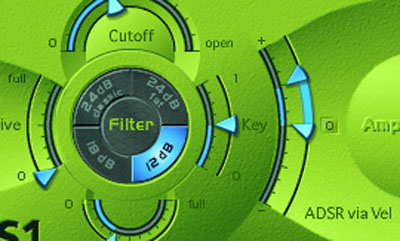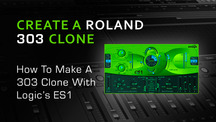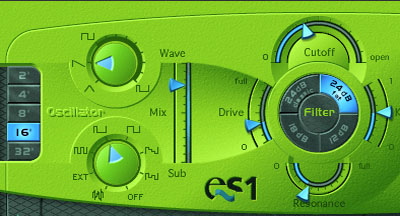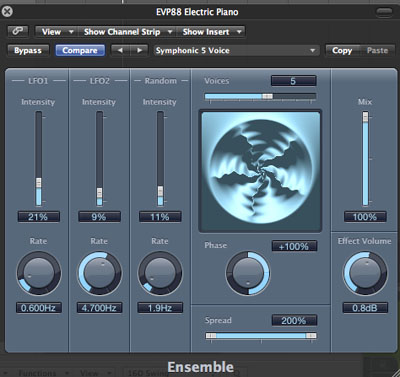Here’s a great tutorial on how to program a 303 clone, a replica of Roland’s classic acid machine the 303 within Logic’s synth the ES1. If you don’t use Logic never fear as almost any synth available will do the job. Obviously, you won’t get the exact result you would ett with the hardware or a bespoke 303 emulator, but for those of you who are looking to get a worthy approximation in your track, this is worth trying.
1. Load in the ES1 and set the oscillator to ‘sawtooth’. Set the oscillator mix so you have only the main oscillator, not the the subsoscillator. The TB303 has no suboscillator and only a dial between sawtooth and ‘square’; you can switch the oscillator to square if you prefer.
2. Set the oscillator range to 16’.
3. Make sure the ES1 ‘Voices’ setting is in ‘Legato mode’ and with ‘Glide’ set to around a 1/3 of the way up.
This setting is extremely important; we must not have notes overlapping and creating chords. We need the ability to slide between specific notes too!
4. Set the ADSR to very fast attack (but not instant, just slightly off will suffice). Set sustain to zero. Set the release and decay to two thirds of the way up.
5. Set the amp to ‘Gate R’ and the ‘level via vel’ triangles to one at the top and the other 2/3 up
Amp set to ‘Gate R’ and level via vel triangles to one at the top and the other 2/3 up
6. Set the filter to 12dB (the TB303 actually has an 18dB filter but the ES1’s filter sounds far more realistic at this setting) and the ADSR via vel triangles at zero and 2o’clock. Drive should be at zero, and ‘Key’ at half way.

Filter Set to 12db, ADSR via vel triangles at zero and 2o’clock, Drive Set to Zero and key at half way
8. Set both modulation faders to zero. There’s no modulation other than ADSR on a TB303!
So, with your synthesiser set up in this way, you should have an approximation of a TB303 coming out of your speakers. That’s only half of the battle: to really get that acid feel you need to play the ES1 like a TB303 too. Which actually means that you mustn’t play it but manually program in a pattern in the style of a Roland sequencer from the early 1980s.
The Pattern
1. Create a one bar region in the arrange area using the pencil mouse tool (esc > No.2)
2. Open that in the piano roll editor and draw in the notes you want to play using the pencil tool. Note that the default length on velocity setting is ideal for us because the note is one 16th note long and the velocity is 80. Remember, no chords!
Here’s where things get really clever. At the moment, you’ll probably have a string of notes, each clearly firing one after the other. The TB303 can do that, but the best patterns use glides, legato and accents to create that classic Acid House feel.
1. Drag the right hand corner of the note that you want to ‘slur’ into the next one to the right so that it overlaps with the next note. This will do two things: it will stop the envelope generator triggering again and it will make the ES1 sweep to the new note’s pitch. Nice!
2. The finishing touch is to add accents. You do this with the velocity mouse tool (esc > No.9). At the moment, all your notes will be at velocity 80. Click-drag up on the note you want to have an accent until the velocity is at, say, 100. That note will not only be louder but it will also be slightly brighter too, just like in the old days.
The finishing touches
Of course, it’s how you adjust the settings on the synth that makes that TB303 ‘performance’. The best ones to play with are the Decay/Release settings on the ADSR, Filter Cutoff, the Filter Resonance and the degree of Filter Modulation (move the fader by clicking between the two triangles). If you want to emulate the changing of the ‘accent’ setting, try moving the top filter triangle up and down. Also, you can adjust the attack setting on the ADSR; moving it up to just under a quarter of the way will give you an accurate ‘filter lag’ sound. The key here is subtlety. The real TB303 connoisseur can also add a touch more resonance on every accented note; this is most easily drawn in with automation.
Clean TB303 sounds went out of fashion in the 80s. Try these effects to dirty up your fake TB303:
1. Bitcrusher. But don’t use it to down-sample the audio. Instead, just adjust the drive setting. This will give you that classic ‘abused preamp on a cheap mixing desk’ grit.
2. Ensemble. This can help a pattern come alive, and adds a nice movement to the sound.
3. Tape delay. Throwing a dash of this into your mix can give the ES1 pattern an extra bounce and sound great with those shrill filter sweeps.
Enjoy!

















